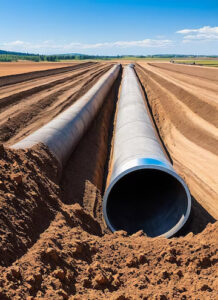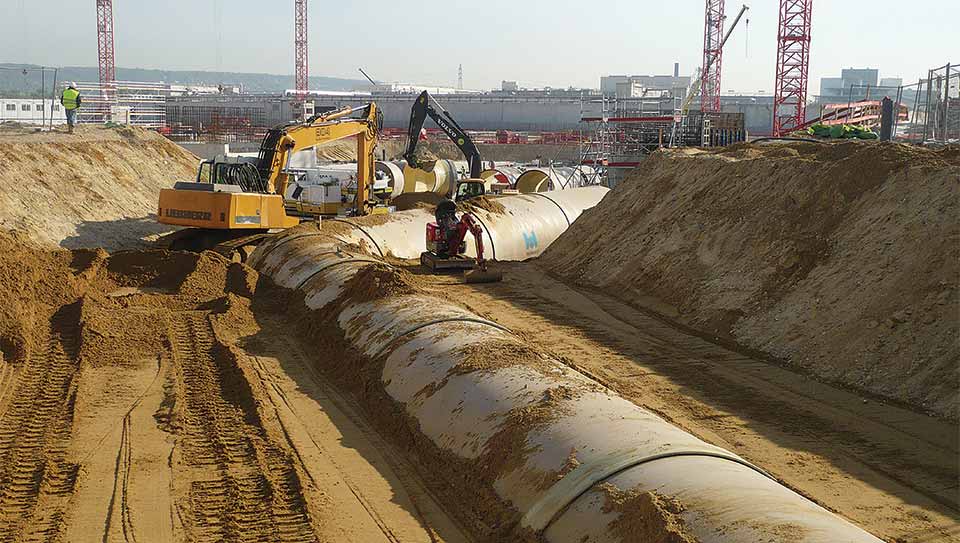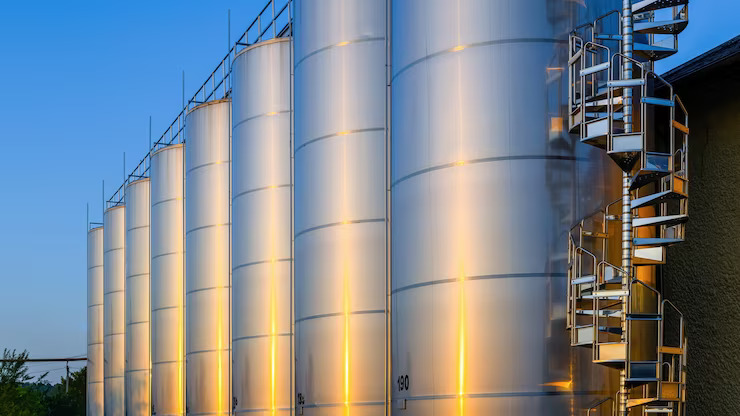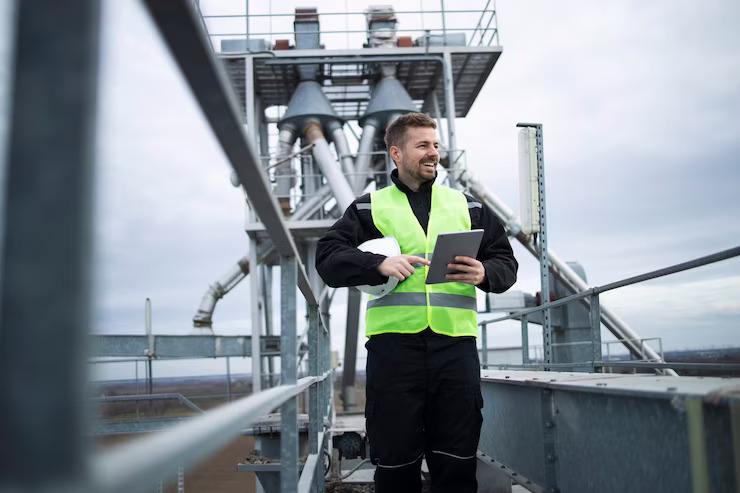build with us
FIBRE GLASS PIPING
Fibre Glass Piping
Choudhary Industrial Services is a leading provider of fibre glass piping solutions for industrial applications. Our team of skilled technicians is well-versed in handling the installation, repair, and maintenance of fibre glass piping systems, offering durable and reliable solutions that meet industry standards.

Process

Installation of Underground GRP pipe
The installation of pipes will strictly adhere to the guidelines outlined in the internationally recognized standard AWWA M45.
Trench Excavation
Trench excavation will be conducted with utmost care to ensure the stability of the sides under all working conditions, and proper dewatering measures will be implemented. The depth of the trench will be determined based on the stiffness class of the pipe, ensuring compliance with the required specifications.
Bedding
The bedding will be prepared by compacting native soil as necessary. In cases where required, the bedding will be prepared by compacting crushed and graded rocks.
Laying
The handling of pipes will strictly adhere to the manufacturer’s specified requirements. Pipes will be positioned in the trench, ensuring compliance with the required elevation, slopes, and alignment. Bell holes will be provided at mechanical joints for proper installation. In cases where the pipe needs to be laid in a curved alignment, angular joint deflection will be carefully maintained within the specified limits.
Joining
The pipes will be joined using a variety of methods, including Coupling Joint, Lamination Joint, Mechanical Joint, and Lock Joint. The Coupling joint will be conducted in accordance with the manufacturer’s recommendations, ensuring that the specified angular deflection is not exceeded.
For Lamination joint, both the hand layup method and the wrap around method will be employed as necessary. The joint design will be carefully crafted to meet the required pressure and stiffness class standards. In instances where joint resin specifications are not provided, the same resin as the pipe will be utilized.
Joining Types
- Adhesive Joint (TB/TS and CB/CS)
- Rubber Seal Lock Joint (RSLJ)
- Coupling Joint
- Rubber Seal Joint (RSJ)
- Lamination Joint
Backfilling & Compaction
The embedment material will be carefully placed to ensure that the pipe remains undisturbed and free from damage. Prior to Backfilling, hunching will be performed to provide additional support. Backfilling and compaction will be conducted in layers, meticulously maintaining the circular shape of the pipe.
Installation of Aboveground GRP pipe

The pipe installation process involves laying the pipe on the designated support structure and performing lamination. In cases where necessary, thrust blocks will be constructed to provide additional reinforcement for the pipe.
Each pipe will be supported by a minimum of two cradles, with one of them serving as an anchor point. The remaining cradle will be designed as a guide, allowing longitudinal expansion of the pipe while restricting lateral movements. In instances where more than two cradles are used to support the pipe, the cradle closest to the middle will be utilized as an anchor. The anchors will be spaced evenly to ensure uniform distribution of longitudinal pipe expansion at the joints.
To prevent direct contact between the pipe and cradle, the interior of the cradles will be covered with a 5 mm thick cradle liner. These liners will be made from suitable materials, such as EPDM, that are resistant to the specific environmental conditions. High friction liners will be applied at anchor points, while low friction liners will be applied at the guides. The design of pipe supports distinguishes them as either anchors or guides. Anchors are designed to restrain pipe movement, while guides allow longitudinal expansion while preventing lateral displacement.
For AboveGround pipes, appropriate support will be provided to withstand the various loads imposed as mentioned below will also be considered in the design of the support system.
- External and Environmental Loads
- Reaction forces resulting from Internal Pressure
- Weight of the Pipe and Fluid
- Rubber Seal Joint (RSJ)
- Friction induced by Couplings and against guides in cases of temperature and/or pressure variations

Fixing of GRP Pipe
Qualified personnel at the jobsite can typically perform quick and easy repairs on damaged pipes. The repair design is tailored based on factors such as wall thickness, wall composition, application, and the nature and extent of the damage.
For cases involving structural fractures in the pipe wall, a thorough evaluation is conducted to determine the appropriate repair method that will effectively restore the original strength of the pipe.
When it comes to repairing damaged or leaking GRP (Glass Reinforced Plastic) pipes, a similar type of resin and glass as the original pipe will be used. The damaged section of the pipe can be repaired by overlaying it after grinding off the damaged area. Alternatively, if needed, a new pipe section will be introduced and laminated.
Likewise, leaks from the joints can be repaired either by replacing the joint with a new one or by using lamination techniques. When extending the existing line, a new connection will be established by incorporating an appropriate branch and saddle arrangement.
Tanks and Spool

We specialize in the design, manufacturing, and supply of a wide range of GRP (Glass Reinforced Plastic) spools, tanks, and fittings for various applications. These include segmented bends, tees, branches, and reducers. The spools are crafted from different resins such as GRP, GRE (Glass Reinforced Epoxy), and GRV (Glass Reinforced Vinyl Ester), depending on the specific application. They are also available in different pressure classes to meet the requirements of different systems.
Our offerings extend to both horizontal and vertical storage tanks, catering to different fluid types such as raw water, potable water, and sea water. We provide storage tanks in various capacities to suit diverse needs.
Additionally, we can supply underground fuel storage tanks that are fabricated using fiberglass. These tanks are capable of storing a range of fuels, including gasoline, aviation fuel, gasohol (a mixture of 90% gasoline and 10% ethanol), jet fuel, diesel, potable water, and wastewater, all while maintaining ambient underground temperatures. The inherent nature of fiberglass makes these tanks resistant to external corrosion, rendering them virtually maintenance-free.

corrosion protection
To provide effective corrosion protection for tank interiors, process equipment, and concrete floors, lining will be applied as an anti-corrosive barrier layer.
The lining process can be carried out using either hand lay-up or spray lay-up techniques, depending on the specific requirements. Different resin options, including polyester, vinyl ester, and epoxy, will be utilized based on the particular application.
Lining surfaces is typically necessary when they are exposed to corrosive chemicals or environments. By applying a lining, the surface is shielded, thereby enhancing its service life and durability.
Our offerings encompass both horizontal and vertical storage tanks, available in various capacities, to accommodate different fluids such as raw water, potable water, and sea water.
Grating

In environments where the service fluid or spillage is corrosive, steel grating often requires frequent replacement due to its limited service life. To address this issue, GRP (Glass Reinforced Plastic) gratings are used. GRP gratings are available in various sizes and shapes, tailored to specific applications. These gratings exhibit resistance to both acidic and alkaline environments. They are manufactured using different resin systems such as polyester, vinyl ester, and epoxy.
Fiberglass grating products have emerged as a reliable alternative to traditional metallic items like galvanized grating, stair platforms, and industrial flooring. Fiberglass grating offers several advantages over metal materials. It does not corrode, is easier to work with, does not require painting, and can incorporate abrasive substances to reduce slips. Additionally, working with fiberglass is generally more convenient compared to metals.
The fiberglass grating is available in a wide range of panel sizes, colors, and depths, ranging from 12 mm up to 50 mm. It possesses corrosion resistance, fire resistance, anti-slip properties, impact resistance, and is lightweight.

Third Party inspection of long term GRP pipe tests.
We offer inspection services at various stages of long-term testing, including HDB (Hydrostatic Design Basis) test, strain corrosion test, and creep test. Our inspections also involve verifying calculations to predict the long-term properties of GRP pipes, following the guidelines outlined in the following ASTM standards:
– ASTM D2992: This standard practice provides guidelines for obtaining the hydrostatic or pressure design basis for fiberglass pipes and fittings.
– ASTM D2584: This standard pertains to the destructive examination of GRP materials, specifically the gel test.
– ASTM D2583: This standard covers the hardness test conducted on GRP materials.
Through our comprehensive inspection process and adherence to these ASTM standards, we ensure the reliability and quality of GRP pipes and assess their long-term performance characteristics.
